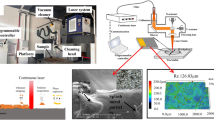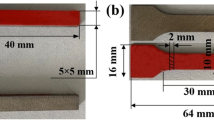Abstract
This paper deals with the laser cleaning of 34CrMo4 steel pipes to be adopted before the electrical upsetting process. The cleaning aims to decrease the pipes’ roughness and the coupled electrical resistance with copper inserts to achieve lower wear and obtain an overall better electrical contact between the pipe and the copper inserts. Compared to a traditional process (shot blasting), the results showed that the laser cleaning treatment leads to a lower pipe roughness and a lowered wear of the copper inserts. The first experimental tests were conducted by using a 30-W Q-switched Yb:YAG fibre laser with different cleaning parameters such as scan speed, pulse frequency, and hatch distance to identify a workability range. Successively, a three-level full factorial plan was developed, and results were analysed through the analysis of variance (ANOVA) to understand which parameters were significant during the cleaning process. Also, the cleaned samples were compared to shot-blasted ones to evaluate the percentage improvements in terms of surface roughness, wear resistance, and coupled electrical resistance. In the third phase, a pre-industrialisation analysis was performed by adopting higher laser power sources (50–100 W) to reduce the cleaning time and define a possible industrial setup. It was found that with the laser cleaning treatment the surface quality increases (about 10 times lower Ra and Rz compared to shot blasting), with a decrease of the wear of about 22%. Moreover, the laser cleaning treatment improves the electric contact resistance and reduces the initial variability compared to the as-rolled sample.












Similar content being viewed by others
Data availability
The processed data generated and analysed during the current study are available from the corresponding author on reasonable request.
Code availability
Not applicable.
References
Snyder CE, Glass SM, Olson KS, Nimitz JS, Cayce JM, Paulson RL (2000) FICs-non flammable, non-ozone-depleting solvents for cleaning aerospace components. Tribol Trans 43(3):528–534. https://doi.org/10.1080/10402000008982373
Harrison AC, Marlow ME, Levi LD (1992) Evaluation of environmentally acceptable cleaners as replacements for methyl ethyl ketone and 1,1,1 trichloroethane in solid rocket motor production and maintenance applications. In: 28th joint propulsion conference and exhibit, Nashville; United States, 6–8 Code 181989. https://ui.adsabs.harvard.edu/abs/1992jpnt.confQX...H
Wolkoff P, Schneider T, Kildesø J, Degerth R, Jaroszewski M, Schunk H (1998) Risk in cleaning: chemical and physical exposure. Sci Total Environ 215(1–2):135–156. https://doi.org/10.1016/S0048-9697(98)00110-7
Li J, Du A, Fan Y, Zhao X, Ma R, Wu J (2019) Effect of shot-blasting pretreatment on microstructures of hot-dip galvanized coating. Surf Coat Technol 364:218–224. https://doi.org/10.1016/j.surfcoat.2019.02.075
Moonchaleanporn P, Songkuea S, Klanpolrang J, Payaksak P, Wongpinkaew K, Bunchoo N, Viyanit E, Manonukul A (2019) Improving corrosion resistance in sintered 304L stainless steel using shot blasting. Int J Mater Prod Technol 59(2):172–190
Atzeni E, Genna S, Menna E, Rubino G, Salmi A, Trovalusci F (2021) Surface finishing of additive manufactured Ti-6Al-4V alloy: a comparison between abrasive fluidized bed and laser finishing. Mater 14:5366. https://doi.org/10.3390/ma14185366
Atzeni E, Rubino G, Salmi A, Trovalusci F (2020) Abrasive fluidized bed finishing to improve the fatigue behaviour of Ti6Al4V parts fabricated by electron beam melting. Int J Adv Manuf Technol 110:557–567. https://doi.org/10.1007/s00170-020-05814-9
Mandolfino C, Lertora E, Gambaro C (2013) Effect of surface pretreatment on the performance of adhesive-bonded joints. Key Eng Mater 554–557:996–1006. https://doi.org/10.4028/www.scientific.net/KEM.554-557.996
Stone MH (1981) Effect of degree of abrasion of composite surfaces on strengths of adhesively bonded joints. Int J Adhes Adhes 1(5):271–282. https://doi.org/10.1016/0143-7496(81)90077-4
Sancaktar E, Gomatam R (2001) A study on the effects of surface roughness on the strength of single lap joints. J Adhes Sci Technol 15(1):97–117. https://doi.org/10.1163/156856101743346
Poloprudský J, Chlupová A, Šulák I, Kruml T, Hloch S (2021) Surface and subsurface analysis of stainless steel and titanium alloys exposed to ultrasonic pulsating water jet. Mater 14:5212. https://doi.org/10.3390/ma14185212
Poloprudský J, Nag A, Kruml T, Hloch S (2022) Effects of liquid droplet volume and impact frequency on the integrity of Al alloy AW2014 exposed to subsonic speeds of pulsating water jets. Wear 488–489:204136. https://doi.org/10.1016/j.wear.2021.204136
Leone C, Morace RE, De Iorio I (2007) AISI 304 stainless steel engraving by Q-switched Nd:YAG nanosecond laser. J Chin Soc Mech Eng 28(2):217–223
Genna S, Leone C, Lopresto V, Tagliaferri V (2015) An experimental study on the surface mechanisms formation during the laser milling of PMMA. Polym Compos 36(6):1063–1071. https://doi.org/10.1002/pc.23442
Leone C, Genna S, Tagliaferri F, Palumbo B, Dix M (2016) Experimental investigation on laser milling of aluminium oxide using a 30 W Q-switched Yb:YAG fiber laser. Opt Laser Technol 76:127–137. https://doi.org/10.1016/j.optlastec.2015.08.005
Leone C, Papa I, Tagliaferri F, Lopresto V (2013) Investigation of CFRP laser milling using a 30 W Q-switched Yb:YAG fiber laser: effect of process parameters on removal mechanisms and HAZ formation. Compos Part A-Appl S 55:129–42. https://doi.org/10.1016/j.compositesa.2013.08.004
Genna S, Menna E, Rubino G, Tagliaferri V (2020) Experimental investigation of industrial laser cutting: the effect of the material selection and the process parameters on the kerf quality. Appl Sci 10:4956. https://doi.org/10.3390/app10144956
Genna S, Tagliaferri F, Papa I, Leone C, Palumbo B (2017) Multi-response optimization of CFRP laser milling process based on response surface methodology. Polym Eng Sci 57(6):595–605. https://doi.org/10.1002/pen.24560
Leone C, Genna S, Caprino G, De Iorio I (2010) AISI 304 stainless steel marking by a Q-switched diode pumped Nd:YAG laser. J Mater Process Technol 210(10):1297–1303. https://doi.org/10.1016/j.jmatprotec.2010.03.018
Astarita A, Genna S, Leone C, MemolaCapece Minutolo F, Squillace A, Velotti C (2016) Study of the laser marking process of cold sprayed titanium coatings on aluminium substrates. Opt Laser Technol 83:168–76. https://doi.org/10.1016/j.optlastec.2016.04.007
Razab M, Noor M, Jaafar M, Abdullah H, Suhaimi F, Mazlan M, Adam N, Yusuf N (2018) A review of incorporating Nd:YAG laser cleaning principal in automotive industry. J Radiat Res Appl Sci 11(4):393–402. https://doi.org/10.1016/j.jrras.2018.08.002
Guodong Zhu, Zhenhai Xu, Yang Jin, Xi Chen, Lijun Yang, Jie Xu, Debin Shan, Yanbin Chen, Bin Guo (2022) Mechanism and application of laser cleaning: a review, Optics and Lasers in Engineering 157 https://doi.org/10.1016/j.optlaseng.2022.107130
Mandolfino C, Lertora E, Genna S, Leone C, Gambaro C (2015) Effect of laser and plasma surface cleaning on mechanical properties of adhesive bonded joints. Proc CIRP 33:458–463. https://doi.org/10.1016/j.procir.2015.06.054
Leone C, Genna S, Caggiano A (2015) Resource efficient low power laser cleaning of compact discs for material reuse by polycarbonate recovery. CIRP J Manuf Sci Tech 9:39–50. https://doi.org/10.1016/j.cirpj.2015.01.005
D’Addona DM, Genna S, Giordano A, Leone C, Matarazzo D, Nele L (2015) Laser ablation of primer during the welding process of iron plate for shipbuilding industry. Proc CIRP 33:464–469. https://doi.org/10.1016/j.procir.2015.06.055
Spadaro C, Sunseria C, Dispenza C (2007) Laser surface treatments for adhesion improvement of aluminium alloys structural joints. Radiat Phys Chem 76(8–9):1441–1446. https://doi.org/10.1016/j.radphyschem.2007.02.047
Langer M, Rechner R, Thieme M, Jansen I, Beyer E (2012) Surface analytical characterisation of Nd:YAG-laser pre-treated Al Mg3 as a preparation for bonding. Solid State Sci 14(7):926–935. https://doi.org/10.1016/j.solidstatesciences.2012.04.029
Galantucci LM, Gravina A, Chita G, Cinquepalmi M (1996) Surface treatment for adhesive bonded joints by excimer laser. Compos Part A-Appl S 27(11):1041–1049. https://doi.org/10.1016/1359-835X(96)88890-7
Buchman A, Kalil C, Dodiuk-kenig H, Rotel M (2001) Microstructure characterization of laser treated surfaces. J Adhesion 77(2):163–181. https://doi.org/10.1080/00218460108030736
Zhang G, Hua X, Li F et al (2019) Effect of laser cleaning process parameters on the surface roughness of 5754-grade aluminum alloy. Int J Adv Manuf Technol 105:2481–2490. https://doi.org/10.1007/s00170-019-04395-6
Zhang FD, Liu H, Suebka C, Liu YX, Liu Z, Guo W, Cheng YM, Zhang SL, Li L (2018) Corrosion behaviour of laser-cleaned AA7024 aluminium alloy. Appl Surf Sci 435:452–461. https://doi.org/10.1016/j.apsusc.2017.11.141
Shi T, Wang C, Mi G, Yan F (2019) A study of microstructure and mechanical properties of aluminum alloy using laser cleaning. J Manuf Process 42:60–66. https://doi.org/10.1016/j.jmapro.2019.04.015
Ma W, Zhao M, Zhao J, Guo Z, Cui Y, Li H (2022) Preparation of superamphiphobic stainless steel surface by laser and perfluorooctanoic acid treatment, Optics & Laser Technology 154 https://doi.org/10.1016/j.optlastec.2022.108321
Maressa P, Anodio L, Bernasconi A, Demir AG, Previtali B (2014) Effect of surface texture on the adhesion performance of laser treated Ti6Al4V alloy. J Adhes 91(7):518–537. https://doi.org/10.1080/00218464.2014.933809
Ma M, Wang L, Li J, Jia X, Wang X, Ren Y, Zhou Y (2020) Investigation of the surface integrity of Q345 steel after Nd:YAG laser cleaning of oxidized mining parts. Coatings 10:716. https://doi.org/10.3390/coatings10080716
Arun S, Thakare, SP. Butee, R. Dhanorkar, KR (2019) Kambale, Phase transformations and mechanical properties of thermomechanically processed 34CrMo4 steel, Heliyon 5 (5) https://doi.org/10.1016/j.heliyon.2019.e01610
Quan G, Luo G, Wen H (2015) Influence of electric upsetting process variables on temperature field evolution by multi-field coupling finite element analysis. Int J Precis Eng Manuf 16:1525–1531. https://doi.org/10.1007/s12541-015-0202-2
Nuasri P, Aue-u-lan Y (2018) Investigation of the “surface dimple” defect occurring during the production of an electric upsetting process by viscoplastic finite element modeling. Int J Adv Manuf Technol 98:1047–1057. https://doi.org/10.1007/s00170-018-2275-4
Funding
This study was partially supported by an academic grant (Funding program VALERE assigned to Emanuele Mingione) from the University of Campania Luigi Vanvitelli. The authors are particularly grateful to the Interuniversity Research Centre CIRTIBS for the equipment and the financial support to develop the present research work.
Author information
Authors and Affiliations
Contributions
All the authors contributed equally to the various aspects of this work: Claudio Leone: conceptualisation, methodology, formal analysis, resources, supervision. Emanuele Mingione: investigation, writing—original draft, data curation, visualisation. Silvio Genna: conceptualisation, investigation, data curation, formal analysis.
Corresponding author
Ethics declarations
Ethics approval
Not applicable.
Consent to participate
Not applicable.
Consent for publication
Not applicable.
Competing interests
The authors declare no competing interests.
Additional information
Publisher's note
Springer Nature remains neutral with regard to jurisdictional claims in published maps and institutional affiliations.
Rights and permissions
Springer Nature or its licensor (e.g. a society or other partner) holds exclusive rights to this article under a publishing agreement with the author(s) or other rightsholder(s); author self-archiving of the accepted manuscript version of this article is solely governed by the terms of such publishing agreement and applicable law.
About this article
Cite this article
Genna, S., Leone, C. & Mingione, E. Surface cleaning of 34CrMo4 steel pipes by using pulsed fibre laser. Int J Adv Manuf Technol 125, 231–244 (2023). https://doi.org/10.1007/s00170-022-10648-8
Received:
Accepted:
Published:
Issue Date:
DOI: https://doi.org/10.1007/s00170-022-10648-8




